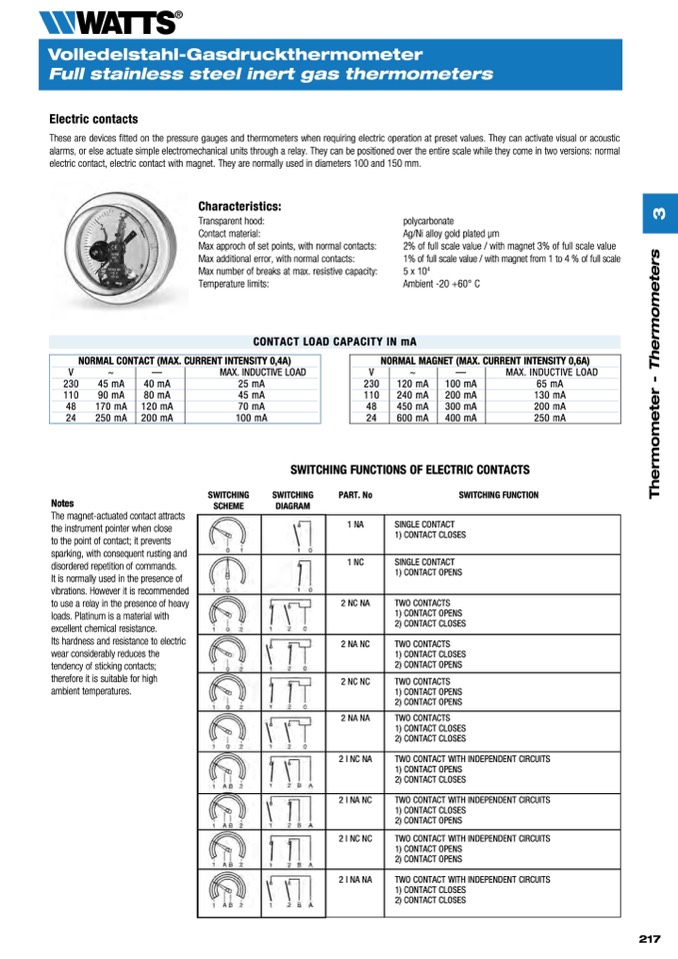
RVoohllrefeddeelsrt-aMhal-nGoamsedtreurckf
üthr eSrtmanodmaertdearnwendungen
BFouullrdsotanintluebses psrtesesl uinrergt aguagsetshermometers
Electric contacts
These are devices fitted on the pressure gauges and thermometers when requiring electric operation at preset values. They can activate visual or acoustic
alarms, or else actuate simple electromechanical units through a relay. They can be positioned over the entire scale while they come in two versions: normal
electric contact, electric contact with magnet. They are normally used in diameters 100 and 150 mm.
Characteristics:
Transparent hood:
Contact material:
Max approch of set points, with normal contacts:
Max additional error, with normal contacts:
Max number of breaks at max. resistive capacity:
Temperature limits:
polycarbonate
Ag/Ni alloy gold plated μm
2% of full scale value / with magnet 3% of full scale value
1% of full scale value / with magnet from 1 to 4 % of full scale
5 x 10
4
Ambient -20 +60° C
CONTACT LOAD CAPACITY IN mA
SWITCHING FUNCTIONS OF ELECTRIC CONTACTS
NORMAL CONTACT (MAX. CURRENT INTENSITY 0,4A)
V
~
—
MAX. INDUCTIVE LOAD
230
45 mA
40 mA
25 mA
110
90 mA
80 mA
45 mA
48
170 mA
120 mA
70 mA
24
250 mA
200 mA
100 mA
NORMAL MAGNET (MAX. CURRENT INTENSITY 0,6A)
V
~
—
MAX. INDUCTIVE LOAD
230
120 mA
100 mA
65 mA
110
240 mA
200 mA
130 mA
48
450 mA
300 mA
200 mA
24
600 mA
400 mA
250 mA
Notes
The magnet-actuated contact attracts
the instrument pointer when close
to the point of contact; it prevents
sparking, with consequent rusting and
disordered repetition of commands.
It is normally used in the presence of
vibrations. However it is recommended
to use a relay in the presence of heavy
loads. Platinum is a material with
excellent chemical resistance.
Its hardness and resistance to electric
wear considerably reduces the
tendency of sticking contacts;
therefore it is suitable for high
ambient temperatures.
SWITCHING
SCHEME
SWITCHING
DIAGRAM
PART. No
SWITCHING FUNCTION
1 NA
SINGLE CONTACT
1) CONTACT CLOSES
1 NC
SINGLE CONTACT
1) CONTACT OPENS
2 NC NA
TWO CONTACTS
1) CONTACT OPENS
2) CONTACT CLOSES
2 NA NC
TWO CONTACTS
1) CONTACT CLOSES
2) CONTACT OPENS
2 NC NC
TWO CONTACTS
1) CONTACT OPENS
2) CONTACT OPENS
2 NA NA
TWO CONTACTS
1) CONTACT CLOSES
2) CONTACT CLOSES
2 I NC NA
TWO CONTACT WITH INDEPENDENT CIRCUITS
1) CONTACT OPENS
2) CONTACT CLOSES
2 I NA NC
TWO CONTACT WITH INDEPENDENT CIRCUITS
1) CONTACT CLOSES
2) CONTACT OPENS
2 I NC NC
TWO CONTACT WITH INDEPENDENT CIRCUITS
1) CONTACT OPENS
2) CONTACT OPENS
2 I NA NA
TWO CONTACT WITH INDEPENDENT CIRCUITS
1) CONTACT CLOSES
2) CONTACT CLOSES
217
T
h
e
r
m
o
m
e
t
e
r
-
T
h
e
r
m
o
m
e
t
e
r
s
3

